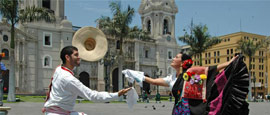Lima History
It’s often said that Lima was founded in 1535 by Francisco Pizarro, the conquistador who toppled the Inca Empire. But a pre-Inca civilisation had thrived here for a thousand years before the Spanish arrived, leaving behind many impressive huacas (enormous pyramids and monuments) as well as beautiful ceramics.
The most prominent site is Huaca Pucllana, a structure built by the so-called Lima Culture on seven staggered levels. The Lima civilisation declined around 600 and by the time the conquistadores turned up, it was part of Inca territory.
The colonial city established in the Ri’mac valley soon became a focal point of the Spanish Empire. A great deal of Andean silver passed through Lima en route to Spain, and some of it funded the colonial mansions and baroque churches whose altars still gleam in the city today.
As the centre of a Spanish viceroyalty that spanned Peru, Ecuador, Bolivia and Chile, Lima was the most important South American capital until the 19th century. It was also here that the Argentine general and legendary liberator José de San Martín announced Peru’s independence in 1821. Afterwards, Lima became the capital of the Republic of Peru, and the city’s Plaza San Martín was named after the general.
Post-independence, the free South American countries didn’t always get along. In the War of the Pacific (1879-1884), Peru joined forces with Bolivia against Chile, which ultimately led to the Chilean army occupying Lima and swiping many of its riches. After recovering from the war, Lima expanded rapidly in the 1900s, with shanty towns beginning to pop up mid-century as a result of the booming population.
In more recent years, the capital was beleaguered by terrorist threats from groups such as Shining Path and the Túpac Amaru Revolutionary Movement. President Alberto Fujimori fought against the insurgents and presided over a period of drastic economic reform during 1990s, but he was later jailed for human rights violations and corruption. Although parts of Peru remain very poor, the economy has grown rapidly since the 1990s, with Lima leading the way as a vital financial hub of Latin America.
Did you know?
• Former president Fujimori is of Japanese descent, reflecting Peru’s sizable Japanese minority, most of whom live in Lima.
• Lima’s Monastery of San Francisco survived earthquakes in 1687 and 1746, but a third in 1970 caused significant damage.
• The historical centre of Lima was declared a UNESCO World Heritage Site in 1988.
Do you have any Feedback about this page?
© 2025 Columbus Travel Media Ltd. All rights reserved. No part of this site may be reproduced without our written permission, click here for information on Columbus Content Solutions.




 You know where
You know where